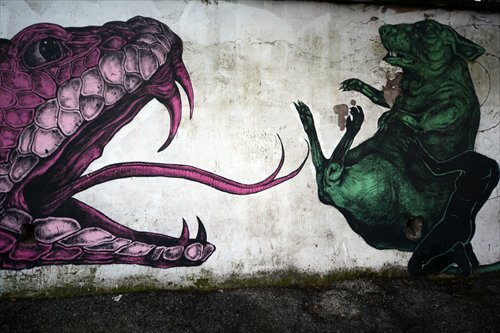In Rome street artists turn suburbs into open-air museum
In Rome street artists turn suburbs into urban art

Steet art adorns a wall in Rome.Photo: Courtesy of Angela Corrias
Just when you think the Italian capital is all about archaeological vestiges and Renaissance frescoes, you are bound to be amazed.
In its enduring struggle to live up to centuries of creation of beauty, the eternal city has been actively promoting one of the most modern forms of visual art, a kaleidoscopic and politically-engaged urban art, with the aim to revamp its so-called "gray areas," otherwise uneventful neighborhoods virtually and physically far from the widely renowned ancient ruins of the city center that have earned the Italian capital the well-deserved moniker of open-air museum.
Environmental art
From Ostiense neighborhood to southwestern suburbs Quadraro and Tor Marancia to more central San Lorenzo, Italian and international street artists have teamed up under the patronage of the city council to keep enriching Rome's open-air creativity and provide citizens with free, daily sightings of contemporary artwork.
Among art lovers and photography buffs these neighborhoods are already a favorite: Detailed maps, available at most tourist information centers, have been released to allow Italian and foreign visitors to find their way and enjoy the graffiti.
One of the most popular street art enclaves in Rome is the aforementioned Quadraro thanks to the initiative of leading local artist David Vecchiato, alias Diavù, who envisioned a project known as MURo, an acronym for Museum of Urban Art of Rome, where murals by Italian and international street artists revamp the once unadorned walls of this suburb.
"The history of the old Quadraro is deeply tied to the one of Rome's 20th century and since I was born here where my grandparents used to live, I know many of the local stories. This is why I thought it would have been interesting to resume them in the subjects of our graffiti," Diavù told the Global Times.
"Unlike other neighborhoods, here the genuine Roman spirit is still alive and this is why I thought a street art museum was the best way to make people know about it.
"The biggest rewards are linked to my vision of public space: seeing the places that enshrine local stories being felt alive by their own proud residents is a nice feeling."
Officially kicked off in 2012, Quadraro's MURo is in constant evolution, with new murals still being added, tours being organized to promote the project and Google maps created to guide visitors across the neighborhood from the metro station Porta Furba Quadraro through the district's different streets . Viewers can see the murals of artists such as the Italian Alice Pasquini, Paris-born Zelda Bomba, Rome's Gio Pistone, Dilka Bear from Kazakhstan, Malo Farfan from Mexico, Beau Stanton from New York and Diavù, among others.
"A big-sized public mural is a big responsibility towards the local community," Alice Pasquini, one of Italy's leading street artists whose work appears all over the world, told the Global Times.
"The local surroundings and history affect my choice of a subject. I let the place inspire me beauty, so once I leave, my traces keep evolving alongside the city."
In what can be seen as a payback of this often condemned form of art that is now invading one of Europe's most artistic capitals with its ideals of making culture easily available to everyone indiscriminately, the messages of the Quadraro-based experiment are far from being consigned to a single area.
As Rome has never been frugal aesthetic-wise, graffiti is increasingly welcome everywhere. Last year, Tor Marancia disclosed the pretty impressive Big City Life, organized by the 999Contemporary art gallery. In the span of about two months the entire neighborhood was transformed into a one-of-a-kind public-art district. There, local associations, residents and schools worked with 22 artists from 10 different countries who had gathered in Rome for an adventure on a project that resulted in 22 monumental murals painted over the facade of 11 local buildings.
Urban make-over
"We need beauty. In the past, the cities were created by great artists, but then they started spreading without rules. I would say, some public art was born for the need of world artists to fill these gaps in the urban landscape, to give magic to forsaken neighborhoods that lie far from the glitzy shops of their city centers," Pasquini said.
One of the urban art projects that has recently come to life in Rome is Popstairs. With this project, Diavù is determined to embellish three huge stairs with the face of three actresses.
"Popstairs was inspired by the need to open a debate about the beauty of urban areas," the artist said.
"Again I tried to resume lost memories through women of the Italian cinema represented in areas where some of their movies were shot. I would like to paint more of these monuments devoted to women linked to Italian culture to celebrate both at the same time."
"Rome is already one of the world's most important collections of open-air artwork," Diavù explained.
"But this applies only to the city center. So why can the city center tell us about our ancient history through monuments and artwork and we can't have the right to represent today's society through our own symbols?"
As the eternal city continues to evolve, now more than ever we can enjoy a Caravaggio alongside one of Alice Pasquini's murals, a Michelangelo only a stone's throw away from a Diavù, not in competition, but instead united in the common cause of spreading beauty and promoting culture.
Newspaper headline: Italy’s open-air museum